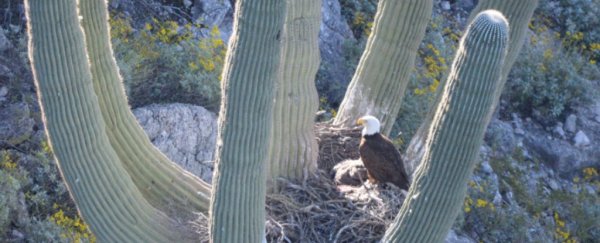A few years before World War II, an American trader by the name of Kermit Lee discovered something on the lower Verde River in Arizona that needed to be written down.
A record from his trading post in 1937 details a large and empty bald eagle's nest, tucked not in a tree, but in the arms of a massive saguaro cactus.
For decades, the incredible sighting was completely forgotten, and then in the 1970s, when bald eagles in Arizona reached dangerously low numbers, the historical account was re-discovered.
For more than three decades, biologists at the Arizona Game and Fish Department (AZGFD) have kept their eyes peeled for one of these peculiar cactus nests, ultimately to no avail.
Now, for the first time in decades, we actually have photos of this behaviours. While bald eagles have been documented nesting in other species of cacti in neighbouring states, no such thing has ever been seen or snapped in Arizona.
So when state biologist Kenneth "Tuk" Jacobson first got the call tipping him off, he didn't necessarily believe it. It was only when he saw two adult eagles fostering their little eaglets atop a sprawling saguaro with his own eyes, he could finally accept the victory.
"It's been an 18-year trek for me, keeping my eye out for a bald eagle nest in a saguaro, so finally finding one is amazing," Jacobson said in a statement.
How Arizona is this! Our eagle survey team captured this image of a bald eagle family nesting in the arms of a saguaro - a rare sight! In fact, it's the first time an image of eagles nesting in a saguaro has been captured in Arizona. pic.twitter.com/OmXRGi9mVE
— Arizona Game & Fish (@azgfd) April 16, 2020
A bald eagle nest is actually called an aerie, and with enough effort, they can get fairly gigantic. It's not unusual for these structures to reach 1.8 to 3 meters (6 to 10 feet) in diameter and about 1.8 to 3 meters (6 to 10 feet) high, so a sturdy base is more than necessary.
Most of the time that means a tree of some sort, but in the Sonoran Desert, which covers some of southern Arizona and slips into Mexico, the saguaro cactus (Carnegiea gigantea), the largest in the United States, is a nice alternative.
This species grows extremely slowly - a 10-year-old plant may only be a few centimetres tall - but because it can live for hundreds of years, individuals can get pretty large.
The one featured in these fly-over photographs is likely very old, so why are nesting eagles only turning to these habitats now?
Bald eagles in Arizona have had a fantastic recovery since they were listed under the Endangered Species Act in 1978, and Jacobson thinks this rare sighting is a sign of their success.
Back in the 1970s, eagles in this state had only 11 breeding areas, confined to a relatively small area. In 2019, state biologists counted 89 nests.
"We've watched that population grow up through the entire river system to central Arizona," Jacobson told AZCentral.
"As this population continues to grow, we're starting to see them in more and more areas using more and more unique substrates."
But that doesn't mean bald eagles are in the clear. While the population has rebounded, state biologists are not revealing the location of this saguaro nest for fear it will put this eagle family at risk.
"We want to share the news, but we don't want to attract a bunch of people and cause problems for the birds," added Jacobsen.
For now, we just have to marvel from afar.
